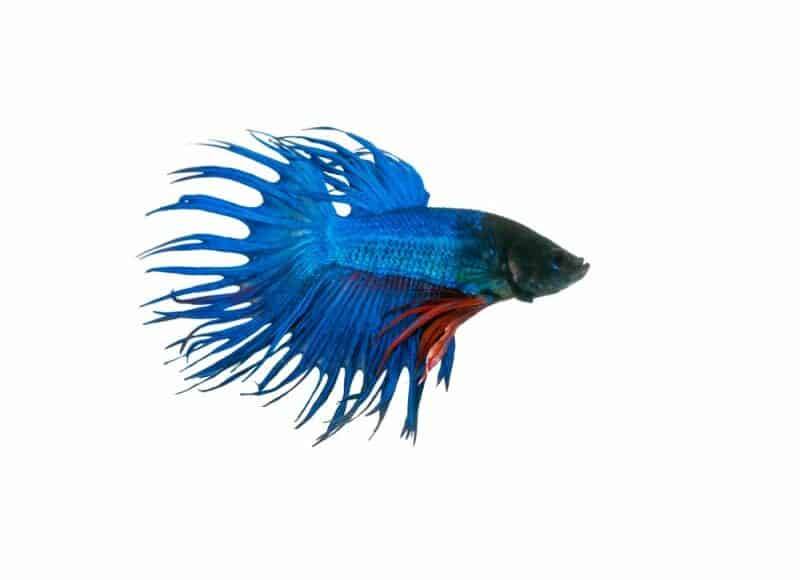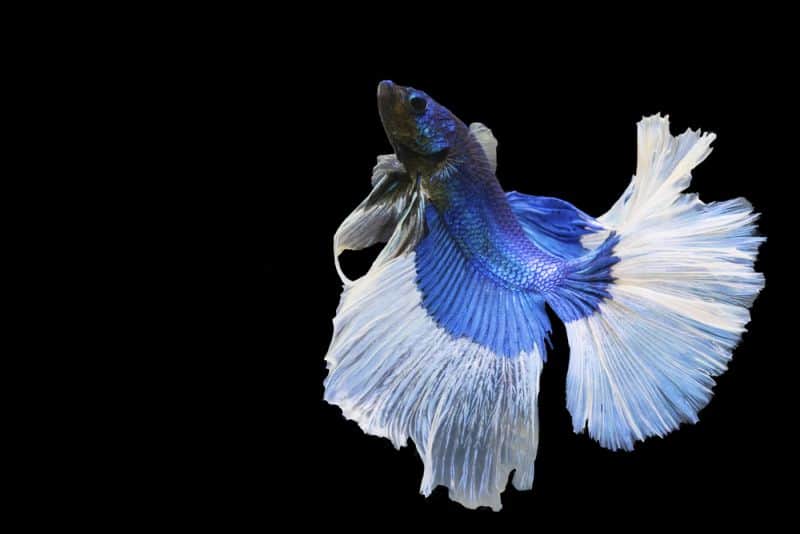Last Updated on June 23, 2022
Ever wondered why the betta fish is so popular? It’s not only because of its colorful body and fins but also as a result of its variety. There are many different breeds that bettas usually come in – classified by their color variety or pattern type, tail size/type, etc.
All this means is if you’re thinking about getting one for yourself, it pays off to do your research first to know which breed suits you best!
In this article, we will discuss one of the betta splendens varieties: the butterfly betta fish.
Table of Contents
Butterfly betta fish care sheet
| Minimum Tank Size: | 5 Gallons |
| Diet: | Carnivore, Protein-rich diet |
| Average Lifespan: | 3-5 years |
| Size: | Approximately 2.5-3 inches |
| Disease: | The common ones include popeye, fin rot, fin infection, and bacterial infection from leftover food |
| Decorations: | Plants and toys |
| Tank Maintenance: | Weekly partial water renewal with a water temperature of 72 to 82 Fahrenheit (22.2 – 27.8 Celcius) |
What is a butterfly betta fish?
Most people are familiar with the traditional freshwater aquarium fish which is the betta fish. They are known for their aggressive behavior (especially male betta fish) that’s why if you’re planning a community tank, make sure to choose the best tank mates for your magnificent fish.
Being a colorful fish, the betta species makes an excellent addition to any home aquarium or private pond.
In fact, one variation of this beautiful creature is called the butterfly bettas!
Native in Southeast Asia, wild bettas are bred to different variations like:
- dumbo bettas (or elephant ear betta)
- rosetail betta
- dragon scale betta
- plakat betta
- pineapple betta
The butterfly pattern type is when a betta has one solid color that extends into the base of its fins. The color then stops in a strong, distinct line while the rest of its body remains translucent or pale.
Usually, the fins and tails of the butterfly betta are white or transparent. Its flowing fins coloration is essentially two-tone like an extra color band on the outer half of each fin circling around the betta’s body color.
Blue halfmoon butterfly betta

In the wild, betta fish’s colors are usually green and brown with short rounded fins. The blue halfmoon butterfly betta is one of the many color variations of the butterfly betta fish family.
With varieties that include many different colors and types of fins, the half moon variety has a D-shaped caudal fin.
This tail type of the halfmoon butterfly betta goes well with the butterfly’s distinct color bands on its fancy fins.
Care guide for your siamese fighting fish
Knowing the basics of caring for your butterfly betta fish is very essential. Here is what you need to know before starting your aquarium hobby in keeping a betta fish!
Tank size
Your butterfly bettas may be a small fish, but that doesn’t mean that they should also be kept in small spaces like a fish bowl!
Bettas thrive best in shallow waters with enough space to swim around. To achieve this, at least a 5-gallon tank is recommended so that your little friend will have its hiding places.
- SLEEK DESIGN: Rounded corners and clear glass canopy allow viewing from multiple angles.
- DAYLIGHT/MOONLIGHT LIGHTING: Bright white LEDs create a shimmering sunlight effect; blue LEDs produce a moonlit glow.
- EASY ACCESS: Hinged LED lighting and sliding glass canopy.
- SIZE: 5-gallon aquarium fits Marineland Rite-Size Z Filter Cartridges.
- HIDDEN FILTRATION: Advanced, 3-stage filtration is out of sight, enhancing aquarium viewi
Prices pulled from the Amazon Product Advertising API on:
Product prices and availability are accurate as of the date/time indicated and are subject to change. Any price and availability information displayed on [relevant Amazon Site(s), as applicable] at the time of purchase will apply to the purchase of this product.
Adding some toys and plants would also make things nicer given how curious these little guys can get. Just keep in mind to provide them with a shallow tank to make it easier for them to swim at the surface.
This will help so that their fins won’t get tired when trying to reach the surface for air bubbles. Luckily, most of these guys will eat at the top of your tank and won’t bother feeding on any surfaces, lessening the dirt from your betta tank!
Water parameters
Stay on top of your fish’s water temperature and pH levels with the help of a handy heater and thermometer, and you will be able to keep them living in perfect conditions!
The recommended water temperature for bettas ranges from 22.2 and 27.8 Celsius. While the perfect pH level of 6-7.5 in their aquariums will help keep them healthy so make sure you’re using the right hardness levels: 2 – 12 dKH.
Filtration system
The water in your fish tank should always be clean, so make sure to install a filter!
- Dense floss removes particles and debris
- Activated carbon removes toxins, odors and discoloration
- Patented bio-holster removes toxic ammonia and nitrites
- Diffuser grid removes additional toxins while adding oxygen for more active fish
- Reduces splashing making the return exceptionally qu
Prices pulled from the Amazon Product Advertising API on:
Product prices and availability are accurate as of the date/time indicated and are subject to change. Any price and availability information displayed on [relevant Amazon Site(s), as applicable] at the time of purchase will apply to the purchase of this product.
A healthy fish tank is necessary to keep your prized pet happy. Installing a filtration system will help you maintain and improve the water quality, but if it’s too strong then they might not be able to swim comfortably!
Remember that partial water changes are needed every week as well as cleaning out any of the substrates in their environment.
Diet
This fascinating creature is flexible when it comes to food!
In the wild, they eat invertebrates and sometimes even algae. And in captivity? You can feed your butterfly betta dried or live foods as well as frozen ones such as brine shrimp.
Feeding your betta a high protein diet will be perfect for their survival rate!
Temperament
Aside from their beautiful color pattern, betta splendens are also famously known as fighting fish due to their aggressive behavior (especially male bettas towards each other). Although female betta fish can also be aggressive, they can be more social with other fish in the same tank.
If you are planning to house other fish together with your betta, consider first the personality of your little friend. Although they have their reputation, it’s not impossible for your pet to coexist with other species!
Size
Bettas typically grow to around three inches in length, but many are much smaller than that. Their growth rate usually depends on their lineage and the nutrition they receive from their food.
Lifespan
The average lifespan of a betta fish is around 3-5 years. However, there were others documented to live longer than their average lifespan.
A lot of it has to do with how well you take care of the needs of your pet fish – their food and environment will affect this too.
Interesting facts about betta fish

- The labyrinth organ of a betta fish allows them to breathe on the surface of the water. That is why they thrive best in shallow waters.
- Bettas are being promoted as the national fish of Thailand.
- Aside from the halfmoon tail type, there are more tail types of betta out there. There are rosetail, crown tail, spade tail, plakat, delta, and more!
- Bettas are always up for a fight and they’re not afraid to show it. When threatened (or hungry), they will stick out their gill covers and expand all of their fins in order to make themselves look bigger.
- When bettas are ready to mate, their colors become more vibrant and saturated. Maybe this is a way for them to show females what they’re after?
Conclusion
Butterfly betta fish are attractive and charming, but they require the same amount of care as other fish. Do not see them as low-maintenance alternatives because they definitely aren’t!
If you decide to get one as a pet, give them the best care possible so that they can fully prosper in their environment.


